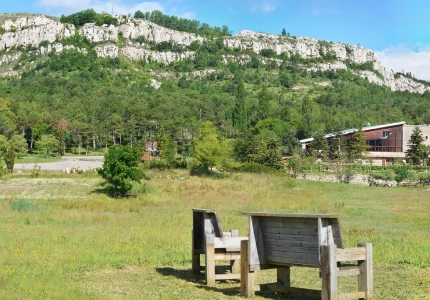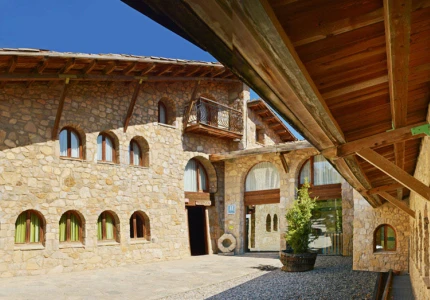In this post we will stop specifically on hiking . Because… is there an easier activity to do that helps you relax, that allows you to enjoy family chat time, good for your health and with which you can get to know places close to your vacation stay?
Hiking allows you to get to know and explore the place in a calm way, savoring it little by little and helping you to penetrate the history and lives of its people. In addition, walking you can get closer to nature and landscapes at your own pace.
El Berguedà is a perfect area for hiking as it offers countless routes. Its network of trails adds, nothing more and nothing less, than 2,000 kilometers linking its different towns, with a selection of more than 7 0 itinerary proposals .
Given such a large number of options, you had better be as well prepared as possible so that you can enjoy yourself to the fullest. Here are some practical tips to make your hiking day a success:
- Wear comfortable clothes and shoes. Not forgetting caps to protect you from the sun.
- Don't forget the provisions. Water for everyone and something light to snack on like dried fruit or a piece of fruit.
- It is also important to have a small first-aid kit with the essentials: plasters, anti-mosquitoes, sun cream ...
- Check the weather forecast before leaving. It never hurts to wear a raincoat in case the weather changes and a storm surprises you.
70 options at your fingertips, can you keep only one?
Most paths are correctly marked but before starting a journey it is advisable to ask the tourist office because there are some sections that may not be perfectly equipped.
Although we do not want to spoil what you can find in this area, we anticipate that bridle paths await you that still remember the proud step of the knight and troubadour Guillem de Berguedà, or the step of the reapers who crossed the imposing Cadí. The Camino de los Cátaros, the Camino de Picasso, the Ermitaño route, the Llobregat green route and much more.
We cheer up and we choose a couple of routes to do as a family , a perfect plan to live adventures with the little ones. However, there is an option tailored to each one, so in this link you can download the information about the different options to see which one best suits you. Number of kilometers, approximate crossing time, difference in level, level of difficulty ... You will find everything you need to choose from.
Route of El molí de Gósol i Torrentsenta
Difficulty: Very easy
Duration: 2 hours
Distance: 7 kms
Maximum altitude: 1,460 meters
Route map: check it here
What will we see on this route?
El Gósol was a place only accessible with animals until the 1940s, so it retains the charm of having been a place apart from the modern world. In addition to the possibility of getting to know Pedraforca, it is worth visiting the ruins of the old town, grouped around the castle located on top of a hill; the ruins of the church of Santa María which, having been restored, allow you to climb the tower to enjoy the panoramic view of the place and without forgetting the museum commemorating Picasso's stay in the town.
Description:
We start at the main square of the town and follow the main road towards Saldes, until the roundabout at the entrance to the town where you continue along the forest track that goes to the right. We will go down next to the fields until we reach the Gósol mill. The route crosses the river and after about 200 meters it begins to gain height. After a last ramp, the route comes out onto a track where we will have to turn right to pass by the Borda del Tinent house. From there we find a shortcut that at the end will find us with the track. At the foot of the track there are some water jets to cool off a little. It is not long before reaching the source of Torrentsenta, where there is a well-equipped picnic area with barbecues. The return can be done on a wide track.
Tramvia of sang
This route goes to the El Jou Nature sidewalk so it becomes the perfect option to do first thing in the morning and be back at the hotel to enjoy a delicious meal and rest a little.
Difficulty: easy
Duration: 3 hours
Distance: 9.2 kms
Maximum altitude: 810 meters
What allows us to see this route?
The blood tram from the Fígols mines was the first mining railway in Berguedà. It was built on the initiative of a Calaf merchant and was used to transport coal from the Fígols mines in Berga. It had a length of 14.5 km and began to circulate in 1871. The recovery of a section of this blood tram allows a pleasant walk between Sant Jordi de Cercs and Berga. The route allows us to enter wooded areas, with tunnels and walkways of various types (including a 35-meter cable). The proximity to the Baells reservoir offers beautiful views of the space.
Description:
We start next to the Sant Jordi de Cercs school, taking the forest track that will take us to Peguera. We will leave that track to take a path on the left that goes down until we find the Peguera stream. The route continues to the left where we will leave the train track and take a path to the right that will take us to the Casanova de las Garrigues road. Here was a bridge that is no longer preserved, so you will have to climb to go back down. Once on the road, keep going down to the left for 1 km, to reach the old train platform again. At the height of the Cercs tunnel on the C-16, you will have to deviate from the mouth by going up some steps and then going down and taking the path again. The same will happen a little later to save a small section, but this time without stairs. We will stop at the same road that we will follow for one km in a southerly direction. When sighting some farms on the road, we will take a path on the left until we find the original layout of the train track. From here the most beautiful and best preserved part of the road begins, which we will only have to leave in two small sections to avoid two slopes of the C-16. A minimum effort that will allow us to enjoy the great engineering works of this route: bridges, stone walls ... until we reach the old Cercs road that will take us south to Cal Curriu, the final station on this route.














